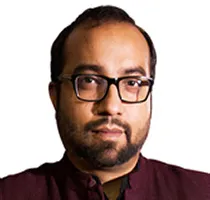I was not one of the more than 200 million Indians on TikTok. I did download the app once but it was, even by the standards of social media, overwhelming: a sort of cascade of practically unsorted, apparently random short videos — the motivation for most of which was clearly beyond my poor and perhaps superannuated understanding.
So it is not as a TikTok addict that I responded with some dismay to the Indian government’s
decision this week to “ban” it alongside 50-plus other “Chinese” apps. I’m disappointed because the move seems both pointless and arbitrary.
Pointless because, after 20 Indian soldiers were
killed in a fight with Chinese soldiers in the high Himalaya, banning a few apps seems like a pretty weak retort. Yes, there are legitimate concerns about TikTok harvesting user data and sending it back to China; a
class-action lawsuit in California argues precisely that. The app has
censored videos critical of the establishment in Beijing. And, just like Facebook, TikTok has had trouble controlling hate speech on its platform.
But, according to India’s communications and IT minister, kicking TikTok out is intended to
safeguard the “safety, security, defence, sovereignty & integrity of India and to protect data & privacy of people of India.” Those are broad ambitions and not one of them wouldn’t be better served by regulation, rather than this ban.
The decision is arbitrary as well. If TikTok, owned by China’s Bytedance Inc., cannot be trusted with Indian data, should we be so certain about the payments company Paytm, in which Alibaba’s Ant Financial Services Group is by far the largest investor? Where is the line being drawn? This is a problem India has already
faced with its decision to scrutinize “China-linked” inward investment.
If nothing else, for the Indian government to shut down a social network like TikTok so heedlessly reveals a lack of empathy and understanding. Whatever its ownership, whatever its problems, there was something special about how and why Indians were using TikTok.
Much more than Facebook or Twitter or YouTube, TikTok in India had an equalizing effect. It was the online home of small-town Indians with outsized dreams and,
if you looked, unforgettable stories. Young men and women from the countryside, in particular, discovered the joys of creativity and, indeed, celebrity on the site. Certainly, nowhere else could a goatherd walking to market
lipsyncing to an old Hindi song gather thousands of views.
Life for many Indians, especially outside metropolitan cities, is relatively grim and even the internet can be daunting, elitist and inaccessible. TikTok was one of the few exceptions — a place where these young people could be who they actually were.
The anthropologist Angad Chowdhry
pointed out last year that, on TikTok, “content creators don’t try to hide context signals, like their neighborhood or the décor in their homes.” That was perhaps one reason for the specific “layer of disgust and resentment” with which elite opinion dismissed the network. The latter is visible, too, in the reactions of the Indian government and its supporters to the ban —
mockery of any possible impact on poorer Indians as “sob stories.”
We should be asking questions, at moments like this, about whether our instincts about state power need to be adapted to a new, digital century. Those who gained not just joy and celebrity but a livelihood from a social media platform deserve more considered decision-making from their leaders.
Yes, some people might shift to another social media network. But who will compensate them for their lost labor? Many users put a great deal of work into their videos, into building a follower network and then monetizing it; some had
millions of followers. How is the ban different, conceptually, from expropriation?
Remember, what is the product of your own past labor, which earns you returns, if not somehow your property? There was a time when what we now call intellectual property wasn’t protected from state action. It certainly is now — and a similar logic should cover the “wealth” represented by the followers some of these young people earned, through creativity and hard work, on a particular platform.
Too many parts of India are not just grim, but limited in the opportunities for creativity and paths to prosperity that they offer. Given that, for many Indians, their greatest asset is their own ingenuity, the government should treat it with more respect.
This commentary originally appeared in Bloomberg.
The views expressed above belong to the author(s). ORF research and analyses now available on Telegram! Click here to access our curated content — blogs, longforms and interviews.




 PREV
PREV


